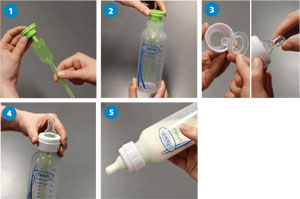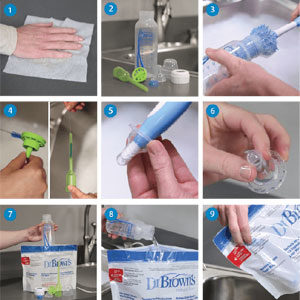Bottle Assembly Guidelines
Zero-Resistance™ Specialty Feeding System:
- To assemble the Internal Vent System, connect the reservoir tube to the insert so that they fit snugly together.
- Place Internal Vent System in the bottle.
- Place the Infant-Paced Feeding Valve (blue one-way valve) into the backside of the nipple/teat.
- Snap nipple/teat into the collar. Ensure nipple/teat and valve are seated securely within the collar.
- Affix collar to bottle and turn until closed (do not over-tighten). If warming the bottle, loosen the collar to prevent fluid loss/leakage.
- Do not warm the liquid beyond body temperature of 98.6°F (37°C).
NOTE: Dr. Brown’s® nipple/teat with the Infant-Paced Feeding Valve (blue one-way valve) in place will fill with liquid as infant elevates tongue to the underside of the nipple/teat during feeding. No manual priming of the nipple/teat is necessary.
Dr. Brown’s® Zero-Resistance™ Bottle Assembly:
- To assemble the Internal Vent System, connect the reservoir tube to the insert so that they fit snugly together.
- Place Internal Vent System in the bottle.
- Snap nipple/teat into the collar. Ensure nipple/teat is seated securely within the collar.
- Affix collar to bottle and turn until closed (do not over-tighten). If warming the bottle, loosen the collar to prevent fluid loss/leakage.
- Do not warm the liquid beyond body temperature of 98.6°F (37°C).
NOTE: No air bubbles will be evident during sucking due to Dr. Brown’s® Zero-Resistance™ Bottle System.
Cleaning and Sanitizing Instructions
Dr. Brown’s products are reusable which requires cleaning prior to first use and after each use.
- Always use clean hands and wash cleaning surfaces with solution appropriate for areas with food contact.
- Prior to first use, disassemble the bottle system, and clean all parts with soap and water, rinse well, and air dry. Consider sanitizing with Dr. Brown’s® Microwave Steam Sanitizing Bags (or comparable process). After each use, the bottle system should be disassembled, washed with soap and water, rinsed well, and air dried.
- Use Dr. Brown’s® Non-Metal Bottle Brush or AccuBrush™ soft bristles to eliminate debris from the interior of the Dr. Brown’s bottle/vessel and collar.
- Use Dr. Brown’s Wire Cleaning Brush to thoroughly clean the internal vent system (i.e., insert and reservoir tube) and Infant-Paced Feeding Valve (blue one-way valve) only. Note: Hospital is recommended to replace the wire cleaning brush every 24 hours after use. Do not use wire cleaning brush to clean nipples/teats.
- Use the chevron tip at the bottom of either nonmetal bottle brush to eliminate debris inside the tip ofthe nipple/teat and assure the nipple/teat hole is clean and open.
- Prior to each use and after cleaning, pull on the nipple/teat in all directions to make sure it does not tear. Note: Replace the nipple/teat prior to feeding if the integrity of the nipple/teat is compromised.
- Consider sanitizing/sterilizing Dr. Brown’s bottle system (disassembled), nonmetal brushes, and one one-piece cone pacifiers at least every 24 hours after cleaning thoroughly with soap and water. Note: Do not place wire cleaning brush into the Microwave Steam Sanitizing Bag.
- Place 2 oz/60mL of water into bag and seal bag tightly. Each Dr. Brown’s ® Microwave Steam Sanitizing Bag can be used for a total of 30 times at the power levels and time frames indicated on the bag.
- Use care when removing bag from microwave as contents are hot. Cool for 10 minutes. Use drain spout to pour out excess water before removing sanitized parts. Note: Follow the directions on the side of the bag and observe the “WARNING -SAFETY NOTE” to avoid injury when using.
For questions, concerns, or additional information regarding the assembly, cleaning, and sanitization of Dr. Brown’s Medical products, please contact us at medinfo@drbrownsmedical.com.
Steam Sterilization (Autoclaving) – All Dr. Brown’s® bottle systems and nipples have been tested up to 30 cycles of autoclaving. (Letter of validation is available if required – Letter to support Steam Sterilization – Autoclave)
NOTE: The Dr. Brown’s Non-Metal Bottle Brush and AccuBrush cannot be Steam Sterilized as the material for the products will not sustain the high temperature.










